A reader sent in a question about Samus’ description in the first Metroid game:
Samus is revealed as a woman at the end of the game, but the English manual for Metroid calls Samus a “he”, probably as an attempt at misdirection. Does the Japanese manual do this too? Does it call Samus a man, or was this misdirection a product of localization?
This was a good question, and it’s something I’ve wanted to know for a while myself, so let’s take a look at the manuals again:
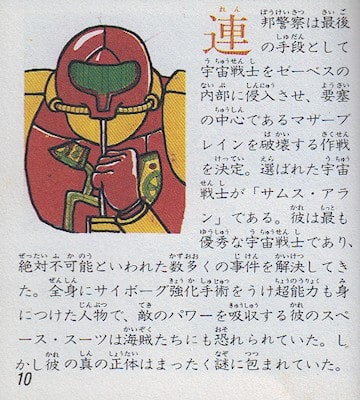 | 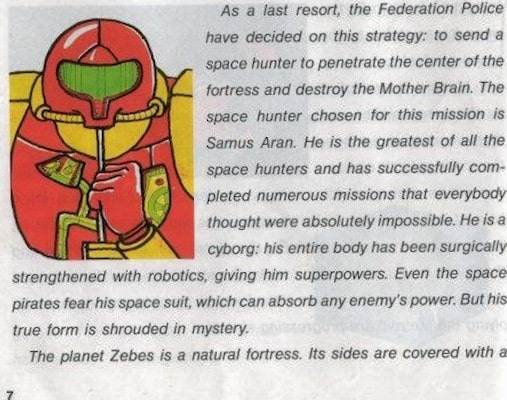 |
| Metroid manual (Japanese) | Metroid manual (North American) |
I started to write out a text comparison for reference, but realized that the translation is surprisingly very close to the original text.
Anyway, some quick background info: the Japanese language doesn’t use pronouns very much, so things like “he” and “she” aren’t used very often at all. Instead, you’ll usually use the name of the person in question, or, if it’s already clear from context who you’re talking about, you don’t need to say anything at all. In fact, Japanese sentences often don’t even include sentence subjects at all. This makes it very easy to write Japanese text without specifying someone’s gender.
I bring all this up because it would’ve been extremely easy for the Japanese writers to keep Samus’ gender a secret. But the Japanese writers went out of their way to use 彼 (kare, "he, him") three times in such a smallblock of text:
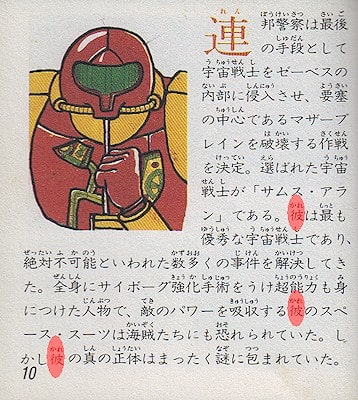
This pronoun use was clearly intended as misdirection, meaning the Japanese writers definitely intended for the player to believe that Samus was a man at first. So this wasn’t a localization change or mistake at all – this trickery was included in the Japanese manual from the very start.



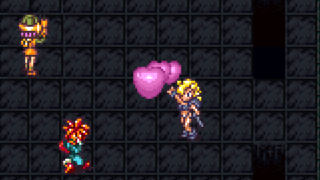
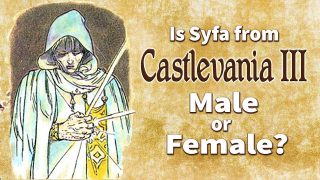

I’m very curious what happened with your Samus search. I tried it — for science, don’t you know — and got pretty much the typical stuff; Wikipedia, official websites, shrines. Even the image search didn’t turn up anything especially untoward.
Well, there wasn’t any nudity or anything, but pretty much just BOOBS BOOBS BOOBS
Well, I’ve heard this internet rumour that he’s really a woman.
Were you guys using “let’s sanitize the net” Google search?
Actually, I take it back, on second look there is nudity in the image search. And lots of creepy fan art.
The image search was definitely more sketchy, but you have to scroll a bit to get to anything particularly outré. If anything, I was surprised by how LITTLE nudity there was. Also how little cosplay.
Was my website (click my name to see) one of the ones that showed up in your search? We used to be an official site until Nintendo dropped us some seven-or-so years ago. And yes, i know this is a shameless plug.
Oops, I should’ve specified “don’t do an IMAGE search” 😛 I’ve come across your site a few times recently though when doing random browsing/searching!
(I’m also jealoussssss I never got Starmen.Net/EB Central to be an official site hrmph)
At the risk of being “that guy:” ironic time to misspell the URL in the “website” field. 😉
Are you telling me Metroid isn’t a robot?! 😀
There’s always Halo right?
eh kills aleins and doesnn’t afraid of anything, after all.
I think it’s also important to mention that in English (at least until very recently) it’s not only completely acceptable but even a standard practice to use male pronouns in situations where gender was unclear. While it’s most likely a form of misdirection that tendency is important. Also though I can’t say for certain why I have seen women in Japanese media occasionally use male pronouns when referring to themselves or even use suffixes like -kun when referring to another woman. Though I can’t say for certain why that happens, I’d assume it’s to refer to women who are a little more “boyish” or “brutish.” Considering that Samus is often confused for a man by people who know very little about video games (or have just never seen her without a helmet) and what little characterization she’s had over the years, this description doesn’t seem totally out-of-place. My point being that it’s certainly a form a misdirection but both in English and Japanese there is some precedent for using those pronouns anyway. Of course I defer to Mato and others more knowledgeable on the subject since my Japanese is not nearly as solid.
“kun” used in reference to girls gives the speaker a certain vibe of its own, it’s hard to explain but it’s not necessarily about masculinity and more about familiarity in certain contexts/situations.
Girls using “boku” or “ore” does give them a more masculine vibe, but I’ve never really sit down and asked native speakers about the nitty gritty nuances and background info of it.
In any case, for reference, she uses the neutral/feminine “watashi” in the games it seems like.
The Wanpakku Comic/Walkthrough does play with the truth about Samus’s gender — she is shown in the opening documentary surrouded by women in swimsuits, and according to the translator’s footnotes, when she comes across a door for the first time during the actual adventure, she says various “magical girl” incantations in addition to “Open Sesame!” (the translator replaced the “magical girl” incantations with “Klaatu Barada Nikto” and “Zoober Zoober Zeeber Zom”).
Neat, I took a quick look at that comic and it seems like something I’d really enjoy. I’ll have to pick up a copy someday!
Interesting. I always assumed it was the manual writers not playing the game and just assuming she was a man.
I only really noticed the whole “the manual lies and says Samus is male” thing when feminists started claiming this as “proof” of audiences being unable to accept their definition of a strong female character – rather than writers just trying to pull a fast one, as it’s clear to be.
(Maybe people don’t like feminist strong female characters because they’re flat and unconvincing, and we already know how to write better ones? No?)
Please define what a “feminist strong female character” is.
Don’t worry. I’ll wait.
Because I’m nine tenths of certain you don’t have a CLUE what “strong female character” is used to mean in feminist circles, and you, like many, are basically making up your own definition without reading anything feminists actually SAY.
I believe that the person you replied to is referring to what a “feminist” is in terms of what gets modern media attention. You know, those radical, extreme types that are essentially just misappropriating the term to defend themselves while pushing agendas that are either about gaining special treatment (rather than the equal treatment actual feminists fought for and may continue to struggle for in less developed parts of the world) or just straight-up misandry. There’s a stark contrast between “I want to be able to vote and join the military and do all the other things, even though I don’t have a penis” and “look at those people not disgusted by a character design that shows more skin than just a wrist, all men are rapists and should be castrated at birth!” yeah?
“(Maybe people don’t like feminist strong female characters because they’re flat and unconvincing, and we already know how to write better ones? No?)”
Maybe people don’t like “Strong female characters” because those same people feel women have little place in gaming.
Interesting. Guru Larry on YouTube claims the manual in Japan actually revealed Samus as a woman in artwork, I guess that’s not true? He claims Samus being a woman being some secret is bullshit made up by video game journalists.